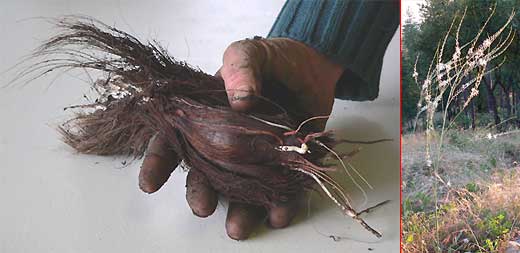
Excerpts from Jim Conrad's
Naturalist Newsletter
from the April 10, 2005 Newsletter issued from the Sierra Nevada foothills
somewhat east of Placerville, California, USA
SOAP PLANT BULB
Possibly awed by my appetite for wild greens, on Thursday my hosts told me about Soap Plant, CHLOROGALUM POMERIDIANUM, famed in these parts as providing an edible bulb. A member of the Lily Family, at this time of year nothing of it is visible except its tuft of slender, green leaves about two feet long and an inch wide, with characteristic wavy margins. Later in the year the plant will send up a flower stalk bearing numerous, small, white flowers with purplish veins.
To me this seemed such an exotic wildflower that I hesitated to dig up a bulb to see how it tasted. However, my friends said it grew everywhere, including right next to their house, so it wasn't long until a bulb was dug up. You can see my hand holding it below:

In that picture you'll see two of the bulb's important features. First, it's fairly large. Second, it absolutely bristles with coarse, dark-brown, hair-like filaments. In fact, books say that the local Indians used those fibers for making brushes.
My friend Diana roasted the bulb on the coals of her wood stove and I have to say that among all the wild bulbs I've ever tasted this is one of the best. Unseasoned it tasted remarkably like white potatoes fried in onion. It tastes so good that I'm astonished that the plant wasn't eaten to extinction by Indians and later-day gold miners who once swarmed through this area.